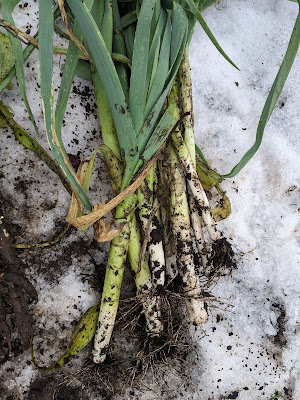It is time to revisit the 4 seasons square foot vegetable bed for the winter harvest. The above picture was taken on 21st December and the ones below were taken today as the crop was lifted. ( If you want to see previous seasons posts just click on "4 Seasons" in the labels list.)
Here is the day's harvest
First prize has to go to parsnips. 5 roots out of 5 and all of them stout and long, The only problem with them was that they grew so strongly that their leaves flopped over their neighbours, depriving them of light.
The leeks also showed well with 6 out of 6 transplants growing long if slender. Some bonus parsley was also grown in the same square foot.
Celeriac was a bit bullied by the parsnip foliage, One tennis ball sized bulb (or swollen stem) would be a fine addition to a stew.
I left the swiss chard in the ground. It has already provided several meals worth from earlier harvest. Light picking over winter progresses but there is plenty more to come in late winter and early spring before new seedlings will catch up with it.
The pigeons had a good go at the Swedes but three survived and grew larger than tennis ball size after netting. These would have happily waited for Burns' night on 25th January.
Beetroots were only salad size, despite the long growing season. To be fair I think the larger ones were raided to make soup by one of the classes. These are just the tiddlers left behind. Also featuring in the picture below is the one mooli (white radish) that reached any size. There were some tiddlers too but this crop was the victim of being overshadowed by it's neighbour - parsnip.
Next is a real experiment: scorzonera. Plenty grew. The roots are long thin and whippy. Very hard to dig out without snapping. There is also the challenge of how to prepare them. Once peeled the white flesh oozes latex and rapidly turns brown. You need to turn to French cuisine to get tips on how to use this exotic ingredient. That said, they grew well regardless of the cold.
The only no show was carrots, which was a victim of its popularity with badgers. No sooner had they reached a reasonable size that the whole square foot was excavated and only the tops left as evidence! I am just relieved that the badgers restricted their mining activities to these (and some potatoes).
It is only a shame that this exercise can only be reported virtually as it was designed as an educational exercise for the children to participate in, Perhaps next year?










This is a brilliant way to demonstrate food through the seasons, hopefully it's an exercise that will be repeated and enjoyed by the children next year.
ReplyDeleteThis was the second year, and lessons have been learnt each time i.e Which crops bully their neighbours and which don't mind being crowded.
DeletePS I have no idea how you would keep badgers off the carrots - my only experience is with the ones that used to push over the dustbin to look for scraps when I was very much younger!
ReplyDeleteI know a market gardener who gave up on carrots. Even when he netted them the badgers dug underneath and attacked from below. They love carrots!
Delete